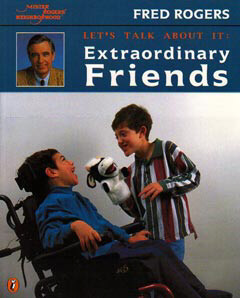
Let's Talk About It: Extraordinary Friends
Written by: Fred Rogers
Photographs by: Jim Judkis
Copyright by G. P. Putnam's Sons in NY in 2000
ISBN: 0-698-11861-8
Genre: Informational Text
Reading Level: Grade 1
Activity Level: Grades K, 1, and 2 (This book could be read to Kindergartners and first graders, but second graders could read this for themselves.)
Summary: This book is about exceptional children and how to interact with them. It teaches children that it is alright to be frightened about something they do not know about, but that it is important to ask questions about that thing and learn about those around us. It also teaches that everyone is unique and special whether one has a disability or not, that we should be excepting of everyone, and that everyone needs love, acceptance, and friends, no matter their situation. This book's intent is to help children who are not accustomed to those different from them be able to accept others' differences and learn how to handle situations in which people from other backgrounds are present.
Response: I have loved the teachings of Fred Rogers since I watched "Mister Rogers' Neighborhood" as a child. I have always thought that he knew the best way to explain things so that all children could understand him and he always gave the best advice and really seemed to understand children from all walks of life. For that reason, I absolutely had to read this book.
Fred Rogers writes this book in very simple language that children can understand and taps into the emotions of all children in unique situations such as fear, inquisitiveness, and concern for others. He is able to address all of these feelings, teach children that these feelings are acceptable, and encourage them to talk with children with exceptionalities in order to relieve their fears, learn from others, and ease their concern.
The photographs in this work are great in that they really show the situations described in the text--how children can be frightened by seeing someone in a wheel chair, but how they can learn from the situation, etc. It makes this book really come to life for the reader and seem more real.
Teaching Connections: With Kindergartners a teacher could read this book to them at the beginning of the school year to help them adjust to meeting all kinds of new people at school. Even if there were not others in the class with exceptionalities, it would encourage them to talk and interact with their fellow students even if they are nervous about meeting people.
With first graders a teacher may read this book at the beginning of the year with them as well, but would definitely use it if a student with an exceptionality joined the class in order to encourage students to not be frightened and to, instead, interact with this individual and learn from him or her.
In second grade this book could be used in either of the aforementioned ways, or as an independent accelerated reader book for these students.
For second graders this work could also be used as a segway into a lesson where the students could interview others in the class and present another student to the class with the many things that are unique about that individual. This activity would help everyone get to know one another at the beginning of the school year.
What Children Learn: Children can learn that everyone is unique and special in their own way, with or without exceptionalities. They can learn from this work to be excepting of others' differences and compassionate toward one another. (Kindergarten health objective
3.02 Conclude and acknowledge that each person is unique and special and first grade health objective 3.04 Conclude that different people have different abilities and summarize the
benefits of diversity.)
3.02 Conclude and acknowledge that each person is unique and special and first grade health objective 3.04 Conclude that different people have different abilities and summarize the
benefits of diversity.)
Image retrieved from: http://www.educationworld.com/a_books/images/bie136_friends.jpg
No comments:
Post a Comment